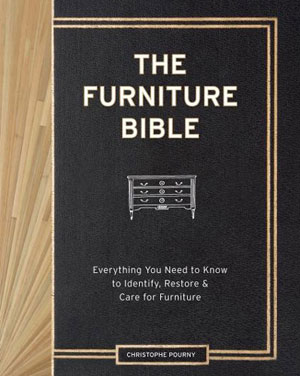
BOOK REVIEW:
The Furniture Bible
, by Christophe Pourny
by J. Norman Reid
Delaplane, VA
Christophe Pourny's just-released book,
The Furniture Bible
, is a welcome, if somewhat niche-oriented, entry into the woodworking market. Perhaps a bit pretentiously named—it does not, after all, attempt to lay a foundation for all things woodworking—it is nonetheless a solid contribution for the aspect of woodworking it sets out to document. That aspect is the field of furniture restoration generally and antiques restoration in particular.
Pourny, raised in the Provençal region of France, studied with his father, a professional restorer of furniture. Later, he migrated to the U.S. and opened up shop in Brooklyn, where he specializes in the restoration and resale of fine furniture. This book is his first, but probably not his last. Given the quality of this offering, further entries by Pourny will be welcome.
The book's objectives are to help the reader locate fine furniture in need of restoration and to inform the steps that can be taken to bring it into top quality condition. Clearly-written and beautifully-illustrated with excellent color photographs and Pourny's own drawings, the book offers step-by-step instructions for restoring furniture, including a number of less common finishing techniques.
The Furniture Bible
is organized into six parts. The first briefly reviews major furniture styles from the 5th century to the modern era, using chairs as examples. For the most part, Pourny emphasizes European styles and especially those of France with which he is presumably most familiar. There is little mention of the Chippendale, Queen Anne, Sheraton and other styles so important in American design.
Part 1 continues with a brief overview of how furniture is made. This includes a glossary of selected types of wood used in furniture, a summary of the types of joinery and an example of furniture construction using an armoire for illustration. This section, while interesting, won't provide much instruction for those already familiar with cabinetmaking. It's intended instead as an introduction for non-woodworkers—dealers, restorers and buyers—who need at least basic knowledge of furniture construction.
Pourny then briefly reviews veneering, marquetry, parquetry, inlay, caning, hardware and the use of leatherwork in furniture. Further discussion is given to shagreen (sharkskin and stingray skin), parchment, tortoiseshell, mother-of-pearl, antique glass, traditional horsehair upholstery and the upholstering process.
The final topic in Part 1 is entitled "The Hunt" and classifies and evaluates various venues—antique shows, antique shops, auction houses, boutiques, consignment shops, flea markets, estate sales and on-line buying—from which restorable furniture may be obtained. This is a useful section for those looking for furniture to restore or who are considering getting into the furniture restoration business.
Part 2—"The Finishing School"—offers an overview of fine finishing methods. These include ceruse, cire rempli, dry wax rub, French polish, shellac, verais Anglais and European lacquer. Also covered are oil finishes, gilding and paint.
Part 3—"Prep School"—considers dismantling, stripping, dewaxing, filling, sanding and staining furniture. The staining process is discussed in detail and illustrated with a bookshelf project. Pourny reviews various types of stains, including chemical stains and stains you can make yourself.
Part 4—"Techniques"—brings together all of his material and illustrates each technique for a specific project. They are cire rempli (a dresser), ceruse (nesting tables), tung oil quench (plant stand), tung oil buildup (dining set), ebonizing (leather-topped flat desk), light ebonizing (bed set), French polish (table with marquetry), French polish restoration (mahogany table), water gilding restoration (round mirror frame), water gilding (gilt mirror), weathered finish (linen press), dry wax rub (paneled door), wood repair (tilt top table), and veneer repair (side table).
Part 5 is the "Tool School" in which Pourny provides helpful information about the tools needed to set up a furniture restoration shop. In addition, he offers recipes for wax, shellac, fillers, French polish pads, glaze and stains.
The final part—"The Care and Feeding of Furniture"—offers fixes for odors, ink spots, sunlight damage, worms, insect damage, spots, stuck doors, broken hinges, split panels, drawer slide problems, marble, teak, wicker and hardware problems. Pourny concludes with a brief discussion of protecting, packing and transporting furniture.
This is an excellent book and will be particularly useful for those who are in, or who seek to join, the furniture restoration business. Restorers, antiques buyers and sellers and others with an interest in antique furniture in particular will find this book of special interest.
But it's not a book for the general woodworker, who is more likely to be seeking information about building furniture—milling wood, joining it and shaping it. That is not to say, however, that many woodworkers will not find the discussions of fine finishing methods fascinating and helpful or the formulas for stains and other products useful. It is simply to state that
The Furniture Bible
is not everyone's cup of tea.
I regard this book as an important contribution in its own niche—furniture restoration—and an excellent resource on problem-solving and restoration techniques. Many woodworkers—especially those who are interested in specialized and period finishing techniques will want to add this book to their libraries, as will those persons engaged in one or more aspects of the furniture restoration and antique furniture business.
CLICK HERE to order your copy of
The Furniture Bible
The author is a woodworker, writer, and woodworking instructor living in the Blue Ridge Mountains with his wife, a woodshop full of power and hand tools and four cats who think they are cabinetmaker's assistants. He is the author of the forthcoming book
Choosing and Using Handplanes
.
He can be reached by email at
nreid@fcc.net
.
Return to
Wood News
front page


